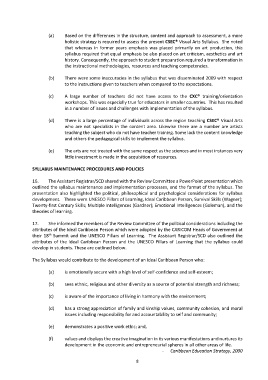Page 1380 - SUBSEC October 2017_Neat
P. 1380
(a) Based on the differences in the structure, content and approach to assessment, a more
holistic strategy is required to assess the present CSEC® Visual Arts Syllabus. She noted
that whereas in former years emphasis was placed primarily on art production, this
syllabus required that equal emphasis be also placed on art criticism, aesthetics and art
history. Consequently, the approach to student preparation required a transformation in
the instructional methodologies, resources and teaching competencies.
(b) There were some inaccuracies in the syllabus that was disseminated 2009 with respect
to the instructions given to teachers when compared to the expectations.
(c) A large number of teachers did not have access to the CXC® training/orientation
workshops. This was especially true for educators in smaller countries. This has resulted
in a number of issues and challenges with implementation of the syllabus.
(d) There is a large percentage of individuals across the region teaching CSEC® Visual Arts
who are not specialists in the content area. Likewise there are a number are artists
teaching the subject who do not have teacher training. Some lack the content knowledge
and others the pedagogical skills to implement the syllabus.
(e) The arts are not treated with the same respect as the sciences and in most instances very
little investment is made in the acquisition of resources.
SYLLABUS MAINTENANCE PROCEDURES AND POLICIES
16. The Assistant Registrar/SCD shared with the Review Committee a PowerPoint presentation which
outlined the syllabus maintenance and implementation processes, and the format of the syllabus. The
presentation also highlighted the political, philosophical and psychological considerations for syllabus
development. These were UNESCO Pillars of Learning, Ideal Caribbean Person, Survival Skills (Wagner);
Twenty-first Century Skills; Multiple Intelligences (Gardner); Emotional Intelligences (Goleman), and the
theories of learning.
17. She informed the members of the Review Committee of the political considerations including the
attributes of the Ideal Caribbean Person which were adopted by the CARICOM Heads of Government at
th
their 18 Summit and the UNESCO Pillars of Learning. The Assistant Registrar/SCD also outlined the
attributes of the Ideal Caribbean Person and the UNESCO Pillars of Learning that the syllabus could
develop in students. These are outlined below.
The Syllabus would contribute to the development of an Ideal Caribbean Person who:
(a) is emotionally secure with a high level of self-confidence and self-esteem;
(b) sees ethnic, religious and other diversity as a source of potential strength and richness;
(c) is aware of the importance of living in harmony with the environment;
(d) has a strong appreciation of family and kinship values, community cohesion, and moral
issues including responsibility for and accountability to self and community;
(e) demonstrates a positive work ethic; and,
(f) values and displays the creative imagination in its various manifestations and nurtures its
development in the economic and entrepreneurial spheres in all other areas of life.
- Caribbean Education Strategy, 2000
8

